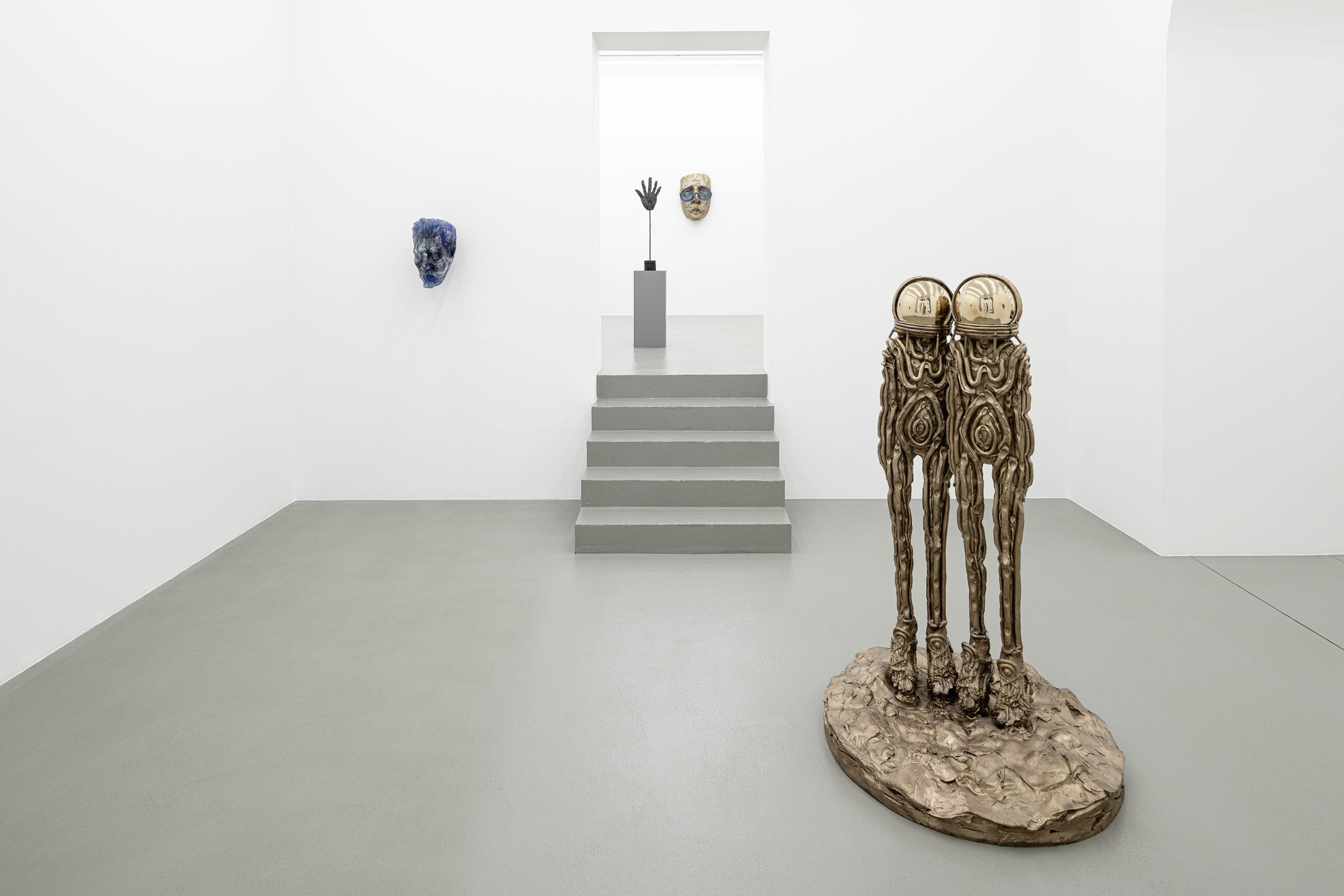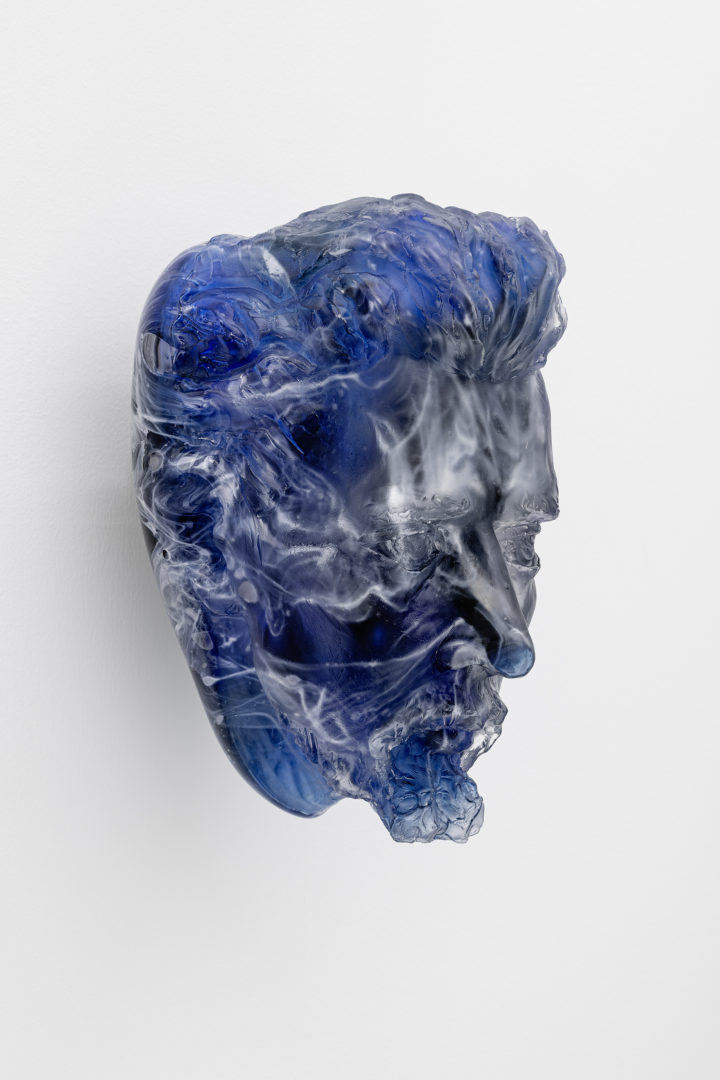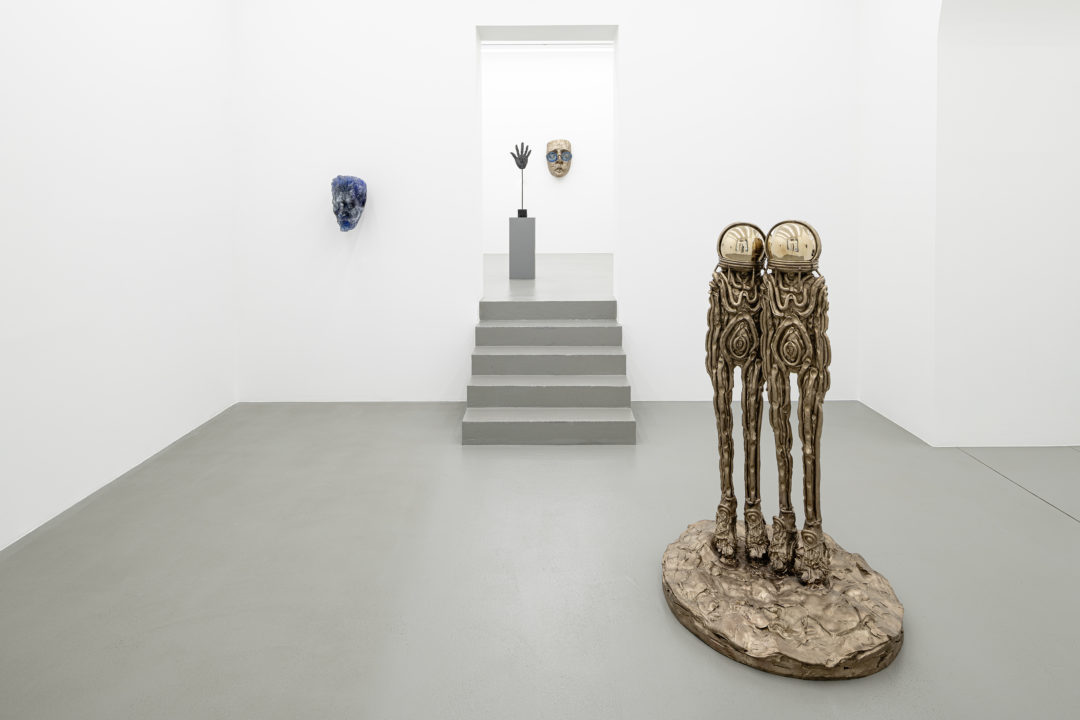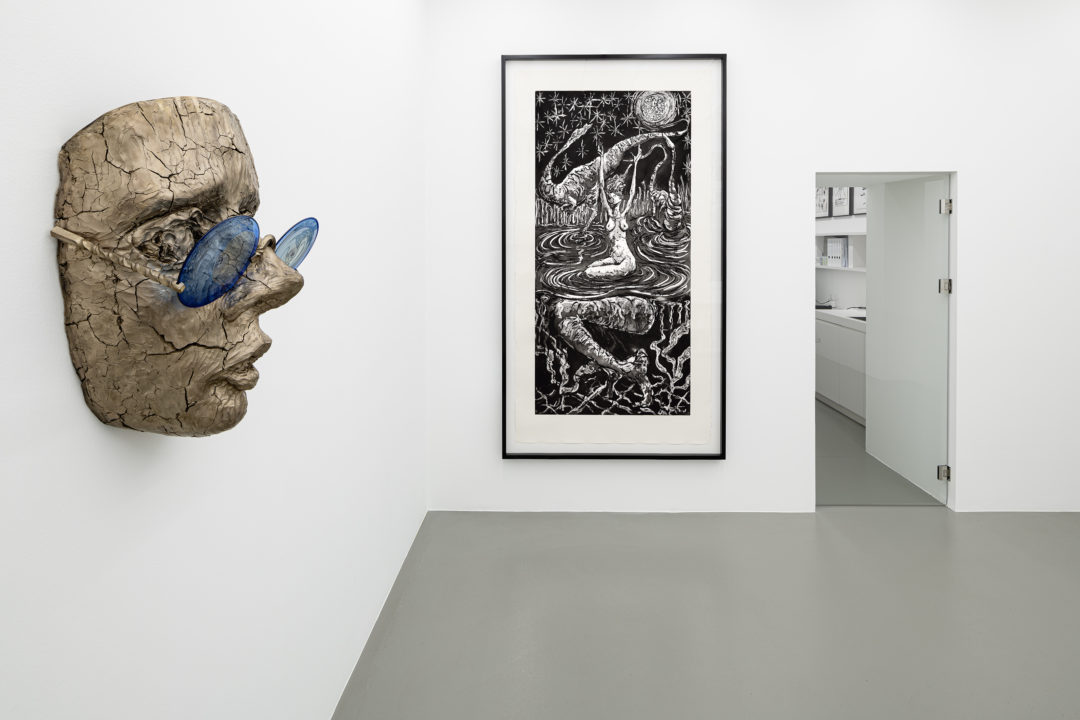Jean-Marie Appriou at Eva Presenhuber Gallery

Gemini, Jean-Marie Appriou
Gallery Eva Presenhuber, Vienne
9 November – 22 December 2023
In the intimate space of Eva Presenhuber gallery in Vienna, Jean-Marie Appriou orchestrates a new production densely weaving new and consistent ideas that diffuse through his work. The title, Gemini, offers the viewer a key to deciphering the exhibition, from its (dual) core and through the multitude of rays it reflects. Its nucleic structure extends into the spatial arrangement, prominently featuring a bronze sculpture titled The Poet and the Sculptor (mitosis), depicting two humanoid astronauts, strategically encircled by three glass busts of Rainer Maria Rilke – Dans la tourmente de l’encre (Rilke 1, 2, and 3).
In line with Jean-Marie Appriou’s artistic approach, the bronze astronauts surpass their mere title, urging us to explore further into their narrative. Observing these enigmatic figures, it becomes evident that they retain a childlike quality, one being slightly larger than the other. Instead of the habitual glass protection, these astronauts wear, for the first time, metal outer space helmets that, like a mirror, reflect both the viewer and the external cosmos. Their androgynous body shapes subtly emerge from their costumes built out of tube-like patterns, intricately adorned with the artist’s finger traces, pushed deep, one by one, into their clothing.

Courtesy the artist and Galerie Eva Presenhuber, Zurich / Vienna
Photo: Jorit Aust
Appriou speaks of them as an anthropomorphic representation of unicellular organism division, the first mitosis perhaps, which split one cell into two, symbolizing the genesis of complex growth, repair, and evolution of life as we recognize it today. The one-become-two characters ascend from a clay-turned-metal plinth, growing tall and floating a few inches above the ground. While the artwork resonates with mighty references from religious, cultural, and scientific realms, Appriou deliberately refrains from imposing these interpretations as obligatory. This intentional ambiguity encapsulates the essence of the artist’s je ne sais quoi—his work exists in a state both full and empty, offering viewers the freedom to choose or contribute their own meaning to the compelling narrative. Consider, for example, the astronauts as a nod to the sci-fi movement, reminiscent of Kubrick’s iconic twins, evoking the stylized futurism of Daft-Punk, or even aspiring to actual space travel. Alternatively, they might be interpreted as tokens of hope, renewal, or even new messiahs, harkening back to the profound concept of the creation of man from mud. Appriou claims none and all of these meanings, underscoring the intrinsic power of the duality emanating from the artwork, a thematic thread interwoven throughout the various subjects he explores.
As a creative mitosis of sorts, Appriou frequently splits one singular mould into an array of distinct sculptures. In fact, none of his sculptural works exist as mere copies in editions; rather, he envisions them as diverse iterations of a singular, unique identity. In this specific exhibition, he unveils three busts of Rainer Maria Rilke encircling the aforementioned astronauts, forming a symbolic triangular constellation within the gallery space.
The role of Rilke in the exhibition Gemini is directly correlated with Appriou’s fascination with the dynamic between the poet and Auguste Rodin. This juxtaposition highlights the contrast between the young, still obscure poet in his 20s, learning from the established and imposing sculptor, who, by his 60s, had already carved out a significant name for himself. While Rilke acknowledged that Rodin’s work had a profound impact on his perspective on life, work, and art, it is often overlooked that Rodin himself praised poetry, or ‘a poet’ in particular. Indeed, The Thinker’s first title was The Poet, and was inspired by none other than Dante in the Divine Comedy.
Creating a metaphorical mirror, Appriou embarks on an archetypal expedition, passionately seeking the sculptor in the poet, and the poet in the sculptor. With tender gestures he sculpts Rilke’s face in clay, signing it by finely impressing his fingerprints on its surface. The sculpture is later hand blown in its mould, with streaks of smoke mixing into the coloured glass. Following a poet’s logic, Appriou translates colors into words, ingraining each bust with a distinct hue and allegorical meaning. He chooses the bordeaux of a withering rose for the first, the blue of a drop of the poet’s ink for the second, and the gray of the contemplation of one’s own mortality for the third.

© Jean-Marie Appriou, Andrew Lord
Courtesy the artist and Galerie Eva Presenhuber, Zurich / Vienna
Photo: Jorit Aust
Yet, beyond the correlation of the two arts of poetry and sculpture, or of the two artists, Rilke and Rodin, Appriou embraces a fundamental theme in contemporary art understanding, which is Empathy. This relatively recent concept, originating from fin-de-siècle discoveries, was formally termed by the psychiatrist Theodore Lipps, a professor of Rilke. Initially centered around the contemplation of artworks, it explores the intricate relationship between the viewer and the artwork. For Rachel Corbett who researched the bond between Rilke and Rodin, empathy played a decisive role in the poet’s rejection of his initial creation after encountering the sculptor. Corbett articulates that “the moment a viewer recognizes a painting as beautiful, it transforms from an object into a work of art”, adding that “the act of looking, then, becomes a creative process, and the viewer becomes the artist.” (1) Rilke’s deep cohabitation with Rodin’s artworks, driven by empathy, effectively positioned him as a co-creator, sparking a profound transformation in his own writing. Empathy perfuses all of Appriou’s works, gently guiding the viewer into a state of active coexistence with the pieces. Through his process, Appriou taps into this fundamental aspect of the viewer’s engagement with art, enriching the contemplative experience and fostering a deeper connection between the observer and the artistic creation.

© Jean-Marie Appriou
Courtesy the artist and Galerie Eva Presenhuber, Zurich / Vienna
Photo: Jorit Aust
Ascending the stairs to the adjacent room we encounter an open hand, cast in bronze by Andrew Lord, who presents a parallel exhibition at the gallery. In its liminality, it remains unclear whether the hand greets or warns against coming in, its presence emphasising the attention to a larger bronze sculpture of a face, hanging on the rear wall. Named The Forgotten Watcher, this figure is a perpetual observer, with time-cracked skin and equipped with a pair of blue glasses gently falling off the nose. As if empowered by a double vision, seeing close up through the glasses, or gazing far out over them, this figure acts as a guardian overseeing the entire space. Clearly, the glasses also function as mirrors – an overarching motif of the show, reflecting us and extending an invitation to cohabit in a world that appears to transcend our conventional notions of time and space.
Concluding the exhibition, in the same room, is a large-scale etching named Old Moon, the sole piece created a few years prior to the show. Evoking the imagery of a tarot card, it portrays a woman emerging from a body of water – the primordial soup, as described by Appriou. While her legs remain submerged, her elongated arms ascend into the starry sky. An alter-ego perhaps to the Forgotten Watcher, the Old Moon assumes a profound role as the creator, the matron, and the genesis, predating all life on Earth. In stark contrast to the other figures, the Old Moon is shown in completeness, revealing her body, head, and face, harmoniously existing as one with her cosmos.
Jean-Marie Appriou’s exhibition unfolds as a poetic journey into a sculptor’s mind, where words take shape, and sculptures emerge as the written pages of a journal. Like the characters of a play, the figures present in the gallery unfold one by one, weaving the plot of a story unique to every viewer, projecting the contemplative realm of Appriou’s sculptural universe into the limitless multitude of simultaneous existence.
(1) Rachel Corbett, You must change your life: the story of Rainer Maria Rilke and Auguste Rodin – W.W. Norton – 2017.
______________________________________________________________________________
Installation view, Jean-Marie Appriou: Gemini, Andrew Lord: a sculpture of my left hand and five embraces, Galerie Eva Presenhuber, Vienna, 2023 © Jean-Marie Appriou, Andrew Lord
Courtesy the artist and Galerie Eva Presenhuber, Zurich / Vienna
Photo: Jorit Aust
- From the issue: 104
- Share: ,
- By the same author: The summer of collaboration at CRAC Alsace and CRÉDAC: “L’amitié : ce tremble” and "Tripple Dribble", Jonathan Binet at Balice Hertling gallery, Radek Brousil at Stone Bell House, Prague, Unbound : Performance as Rupture at the Julia Stoschek Foundation, Berlin, Jota Mombaça at CCA Berlin,
Related articles
Yoshitoro Nara at Guggenheim, Bilbao
by Guillaume Lasserre
Moffat Takadiwa
by Andréanne Béguin
Alias at M Museum, Leuven
by Vanessa Morisset

